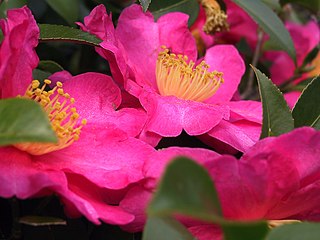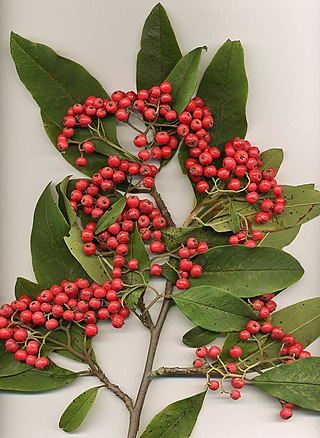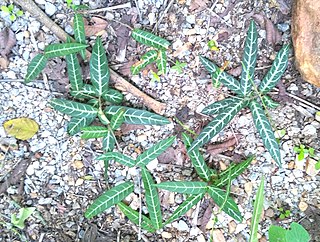
Uncaria is a genus of flowering plants in the family Rubiaceae. It has about 40 species. Their distribution is pantropical, with most species native to tropical Asia, three from Africa and the Mediterranean and two from the neotropics. They are known colloquially as gambier, cat's claw or uña de gato. The latter two names are shared with several other plants. The type species for the genus is Uncaria guianensis.

Camellia is a genus of flowering plants in the family Theaceae. They are found in tropical and subtropical areas in eastern and southern Asia, from the Himalayas east to Japan and Indonesia. There are more than 220 described species. Camellias are popular ornamental, tea, and woody-oil plants cultivated worldwide for centuries. Over 26,000 cultivars, with more than 51,000 cultivar names, including synonyms, have been registered or published.

Wisteria is a genus of flowering plants in the legume family, Fabaceae (Leguminosae). The genus includes four species of woody twining vines that are native to China, Japan, Korea, Vietnam, southern Canada, the Eastern United States, and north of Iran. They were later introduced to France, Germany and various other countries in Europe. Some species are popular ornamental plants. The genus name is also used as the English name, and may then be spelt 'wistaria'. In some countries in Western and Central Europe, Wisteria is also known by a variant spelling of the genus in which species were formerly placed, Glycine. Examples include the French glycines, the German Glyzinie, and the Polish glicynia.

Robert Fortune was a Scottish botanist, plant hunter and traveller, best known for introducing around 250 new ornamental plants, mainly from China, but also Japan, into the gardens of Britain, Australia, and North America. He also played a role in the development of the tea industry in India in the 19th century.

Celastrus, commonly known as staff vine, staff tree or bittersweet, is the type genus of the family Celastraceae; it contains over 40 species of shrubs and vines, which have a wide distribution in East Asia, Australasia, Africa, and the Americas.

Camellia sinensis is a species of evergreen shrub or small tree in the flowering plant family Theaceae. Its leaves, leaf buds, and stems can be used to produce tea. Common names include tea plant, tea shrub, and tea tree.

Cotoneaster is a genus of flowering plants in the rose family, Rosaceae, native to the Palaearctic region, with a strong concentration of diversity in the genus in the mountains of southwestern China and the Himalayas. They are related to hawthorns (Crataegus), firethorns (Pyracantha), photinias (Photinia), and rowans (Sorbus).

Zanthoxylum is a genus of about 250 species of deciduous and evergreen trees, shrubs and climbers in the family Rutaceae that are native to warm temperate and subtropical areas worldwide. It is the type genus of the tribe Zanthoxyleae in the subfamily Rutoideae. Several of the species have yellow heartwood, to which their generic name alludes. Several species are cultivated for their use as spices, notably including Sichuan pepper.

Stewartia is a genus of 8-20 species of flowering plants in the family Theaceae, related to Camellia. Most of the species are native to eastern Asia in China, Japan, Korea, Laos, Myanmar, Thailand, and Vietnam, with two in southeast North America, from Virginia and Kentucky south to Florida and Louisiana.

Alfred Rehder was a German-American botanical taxonomist and dendrologist who worked at the Arnold Arboretum of Harvard University. He is generally regarded as the foremost dendrologist of his generation.

Clinostigma is a genus of flowering plants in the Arecaceae (palm) family. It is native to various islands in the western Pacific.

Betula albosinensis, commonly known as the Chinese red birch, is a species of birch in the family Betulaceae, native to Western China. It is notable for its distinctive peeling bark and is cultivated as an ornamental tree.

Sinomenium is a genus of plant in family Menispermaceae first described as a genus in 1910. It contains only one known species, Sinomenium acutum, native to China, northern India, Nepal, Japan, northern Thailand, and also Korea.
Symphoricarpos sinensis is an uncommon Chinese species of shrubs in the honeysuckle family. It has been found in the Provinces of Gansu, Guangxi, Hubei, Shaanxi, Sichuan, and Yunnan in central and southern China.

Arctous is a genus of flowering plants referred to by the common name "bearberry", a name sometimes shared with certain species of the related genus Arctostaphylos, in particular, A. uva-ursi. Although the two genera are related, certain characters, such as deciduous, marcescent leaves, rugose-reticulate venation, and finely-toothed leaves are more typical of Arctous than Arctostaphylos.

Sargentodoxa is a monotypic genus of flowering plants belonging to the family Lardizabalaceae. It only contains one known species, Sargentodoxa cuneata(Oliv.) Rehder & E.H.Wilson.

Gardneria is a genus of flowering plants belonging to the family Loganiaceae.
Hosiea is a genus of flowering plants belonging to the family Icacinaceae.
Zanthoxylum pteracanthum is a plant from the Rutaceae family.
Cotoneaster ambiguus, the dubious cotoneaster, is a species of flowering plant in the family Rosaceae, native to central China and Inner Mongolia, and introduced to Belgium and Norway. A shrub of dense forests, it is morphologically intermediate between Cotoneaster moupinensis and C. acutifolius. It is occasionally available from commercial suppliers.















